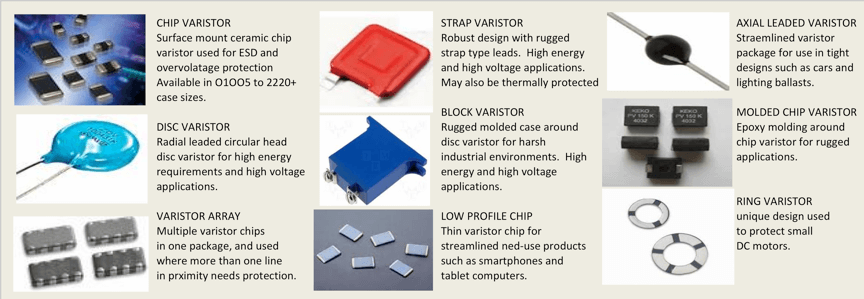Zinc Volatility Impacts Circuit Protection Supply Chain
05/05/2022 //

Zinc is a metal that is consumed primarily in the steel industry for galvanizing, but which also is used in oxide form in the electronic component industry in a very limited but important capacity. The unique crystalline structure of zinc oxide, with emphasis upon its wide gaps between crystals, lends itself to uses in circuit protection components within high voltage circuits.
Circuit protection solutions based upon zinc oxide ceramics in the form of varistors have been a key electronic component to protect sensitive integrated circuits from the effects of voltage transients. Recent price increases for the metal are noted in this article and their impact on variable costs to produce for manufacturers is assessed.
Zinc Ore Sources
Zinc-based ceramics are a good choice for mass production of electronic components because materials tied to steel making and other high volume, materials rich business ecosystems are stable in pricing (other examples of this phenomena include soda bottles for polypropylene and aluminum for automobiles and aircraft). The movement to Industry 4.0 and the rise of ESG compliance are placing greater emphasis upon a materials-based economy to align industries and countries with the Paris Agreement. The process to do this is funded by promises of green bond investments and is an important trend rolling through the high-tech economy and generated from the infrastructure and transportation segments that technology has augmented and will now serve to empower.
Metallurgical processes for obtaining zinc oxide are based on the roasting of zinc ore. Zinc ore mine output worldwide in 2021 was 13 million metric tons (worth an estimated $28 billion USD worldwide), the majority of which came from various primary mines in the People’s Republic of China, Peru in South America, Australia, India, the U.S. and Mexico (see Figure 1).
Figure 1 – Zinc Mine Production by Country: 2021 (13 Million Metric Tons)

Source: Paumanok Publications, Inc. The world market for zinc grew by 11 percent in consumption volume worldwide to support infrastructure rehabilitation worldwide through the consumption of galvanized steel.
Zinc Price Trend
As with most metals analyzed by Paumanok for electronic consumption in the global supply chain, zinc has exhibited some dramatic increases in price since April 2020. During the past 24 months, the metal has reached new 10-year highs, as is shown in Figure 2 below. The 136-percent increase in price between March 2020 and April 2022 will impact the cost to produce varistors, as the majority of variable costs associated with varistor production are associated with the ceramic dielectric, the electrode and termination.
In other articles we have focused on the rising costs of palladium, silver, nickel and copper, which are impacting the costs to produce of sister linear and non-linear components, but in the instance of the ZnO varistor, a staple of ESD protection for all handsets, computers and IOT-connected devices as well as an important solution for EVx propulsion circuits going forward, the price increase is also for the ceramic dielectric because of its reliance on zinc-based metal.
This results in unusual and unprecedented increases in variable production costs worldwide – a regulated playing field based upon materials costs and materials science (there are only so many ways to clamp a transient).
Figure 2 - Zinc Price Index: Average Price Per Ton for Zinc - April 2012 to April 2022

Source: Monthly Market Research Report on Passive Electronic Components - April 2022 Edition
Why the Zinc Price is Spiking
Zinc has always been an excellent example of a stable-priced metal because of its use in the larger steel industry for galvanization, which accounted for 80 percent of global consumption volume for zinc ore in 2021 (See Figure 2.0 below). Only 20 percent of global zinc consumption is for industrial non-galvanized applications, accounting for approximately 2.6 million tons in 2021. However, the use for galvanized steel is enormous, accounting for 10.4 million tons in 2021 consumed worldwide – a significant volume of material.
Therefore, price increases for the metal are largely associated with its proximity to the steel industry, which is managing unprecedented price increases for nickel, also used as an additive. Demand for base metals took an upward turn in 2021 as the world economy recovered on the back of stimulus plans and smelter disruption, particularly in Q4, when European smelters started to cut back production due to record high energy costs in Europe and power disruptions in China.
The simultaneous move toward EVx propulsion and the need for infrastructure improvements put a strain on the metals supply. Meanwhile, pandemic-related closings and logistic snarls continued to hamper vertical supply.
Figure 3 – Global Zinc Consumption Volume by Application (Galvanized Versus Non-Galvanized Industrial)

Source: Paumanok estimates for this MarketEYE installment.
Industrial Zinc Consumption
We estimate industrial zinc consumption (non-galvanized) worldwide at 2.6 million metric tons in 2021 with applications in metal alloys and thermal sprays accounting for 34 percent and 27 percent of consumption, while zinc consumption in the form of oxide was 20 percent of global demand in 2021 (see Figure 3).
Zinc oxide, with its unique physical and chemical properties, such as its high electrochemical coupling coefficient, radiation absorption, high chemical stability and high photo-stability, is known in materials sciences as a multifunctional material with unique characteristics as a circuit protection device for overvoltage and electrostatic events, especially at high voltages. Zinc oxide valve blocks are the only technology consumed to date for the protection of high voltage switching stations serving the power grid.
Figure 4 – Industrial Zinc Consumption: 2021 (2.6 Million Metric Tons)

Source: Paumanok estimates for this MarketEYE installment
Zinc Oxide Consumption in Circuit Protection Components
One of the most important applications of zinc oxide in electronics is in the production of varistors. In materials science, zinc oxide is classified as a semiconductor in group II-VI, whose covalence is on the boundary between ionic and covalent semiconductors.
Varistors are resistors with a non-linear, current-voltage characteristic, where current density increases rapidly when the electrical field reaches a particular defined value. They are used, among other things, as circuit protection components, to protect high-voltage lines and in electrical equipment providing protection against atmospheric and network voltage transient surges. They are available in a variety of configurations and case sizes.
Varistor Component Introduction
Surface mount chip varistors (or multilayered varistors – MLVs) are used primarily for electrostatic discharge (ESD) protection in digital electronics and disc varistors, and small valve block arresters are used for AC power line protection throughout the points of demarcation for power transmission and distribution networks worldwide.
Varistors are ceramic in nature and are created from ceramic slurry composed of zinc oxide and a variety of additives (like bismuth). Varistors are produced in two primary configurations – chip and disc. Disc varistors have been around for 45 years, while chip varistors are relatively new and have been available for about 25 years. Varistor construction methods are similar to ceramic capacitor production methods for both disc and chip versions. Disc varistors are pressed ceramic pill technology, while chips are stacked layers of ceramic and electrode paste.
Surface Mount and Through Hole Varistor Configurations and Variations
As noted, metal oxide varistors are produced in two primary configurations – chip and disc. Disc varistors have been around for 50 years (legacy components), while chip varistors are newer and have been available for about 20 years. Varistor construction methods are similar to ceramic capacitor production methods for both disc and chip versions. Chip varistors have also evolved into array designed (primarily quad packs – four varistors in an 0603 or 0805 package), while disc varistors have evolved into large industrial block designs. Since varistors are, in fact, non-linear resistors, their physical size determines how much energy they can absorb, thus raw material consumption becomes an important part of the cost of goods sold. Also, redundant solutions are employed to gradually dissipate excessive voltage.
Figure 5 – Varistor Component Configurations and Designs

Source: Compiled by Paumanok from company literature
Multilayered Ceramic Chip Varistors – The multilayered chip varistor is a stacked ceramic device that employs varying layers of ceramic (usually zinc oxide but also variations on titanate ceramics may also be employed) between layers of precious metals (usually palladium and silver electrodes). Multilayered ceramic chip varistors are used in portable electronics for protection against electrostatic discharge. Larger chips are also employed for larger surge handling capability in computers, industrial, professional and consumer electronic devices. Case sizes are available in the ultra-small 01005 to the larger 2220 or larger chips.
Disc Varistors– Radial leaded disc varistors have circular heads and come in various head diameters with the larger heads being capable of handling higher voltages. In fact, disc varistors are largely used only for high voltage circuit applications to handle high energy dissipation in electrical circuits.
Varistor Chip Arrays – Chip varistors have also evolved into array designed (primarily quad packs, or four varistors in an 0603 or 0805 package), while disc varistors have evolved into large industrial block designs. Since varistors are, in fact, non-linear resistors. Their physical size contributes to their ability to handle higher levels of transients, or more simply stated, small varistors handle small transient levels and larger varistors handle higher levels of transients, thus like other markets identified in this report, varistors segment into digital electronic markets and industrial or line voltage markets.
Strap Varistors – Usually square in design, robust and rugged, these types of varistors come with strap-like leads and will usually be thermally protected with a specific epoxy resin outer coating. They are used in high energy and high voltage circuit applications.
Block Varistors – These varistor components are also manufactured for use in harsh environments and can withstand large amounts of thermal and mechanical shock. They are usually found in harsh industrial environments and employ a hard molded resin case around a disc or strap varistor and have lugs instead of lead wires or terminations.
Low Profile Chip Varistors – A new design in surface mount varistors is the low profile chip varistor that is employed in handsets and related portable electronic designs such as computer tablets because of its low profile nature.
Axial Leaded Varistors – Axial-leaded components usually are legacy in nature and can be found in automotive electronics and in lighting ballasts, where the lead wire along the axis makes for a more volumetrically efficient solution than chips or discs.
Molded Chip Varistors – This is the new and existing development for varistors – the packaging of the varistor in a molded epoxy case for rugged professional applications where high humidity may be evident and where the molded case will withstand the impact of humidity and add to the thermal shock protection of the finished component. Such molded packages are used in the tantalum capacitor industry in the billions of pieces (for comparative example).
Ring Varistors – The new ring varistor design is used to protect small DC motors from the effects of transients and ESD.
Why ZnO Makes a Good Clamping Component
Zinc oxide ceramics for varistors require a content of 95 percent ZnO with a 5 percent matrix of other metal oxides, such as small amounts of bismuth, cobalt and manganese oxides sandwiched between two metal plates which constitute the electrodes of the device. These electrodes can either be silver for disc designs or palladium and silver for multilayered designs.
Sintered ZnO ceramic for varistors provides an assortment of particle shapes and the deep gaps between individual particles is why zinc oxide works well in I/O ports as a clamping device for excess voltages from electrostatic discharge, line switching and the effects of ambient lightning discharges. Examples of 3D structures of zinc oxide include flower, dandelion, snowflakes, coniferous urchin-like and many more unique shapes. The boundary between each grain and a neighbor forms a junction, which allows current to flow in only one direction. The accumulation of randomly oriented grains is electrically equivalent to a network of back-to-back diode pairs, each pair in parallel with many other pairs. The result of this behavior is a nonlinear current-voltage characteristic, in which the MOV has a high resistance at low voltages and a low resistance at high voltages.
Conclusion: Rising Metal Costs = Impact on Variable Cost Structure of ZnO Varistors
The price of zinc, the primary ingredient in metal oxide varistors (95 percent loading), increased by 136 percent between March 2020 and April 2021. This price increase had a serious impact on the variable cost to produce worldwide for metal oxide varistors.
Variable cost structures in the passive component industry are largely dependent upon raw material prices which are outside the control of the component manufacturer. Therefore, as is noted in this MarketEYE article, even the smallest ecosystems can be affected by rising metals prices and their corresponding variable costs structures.
Expect higher prices for many electronic components that have variable cost structure exposure to metals. Especially in instances where there is proximity to steel making (nickel, zinc additives and coatings), expect even higher component prices in the near term.
Follow TTI, Inc. on LinkedIn for more news and market insights.
Statements of fact and opinions expressed in posts by contributors are the responsibility of the authors alone and do not imply an opinion of the officers or the representatives of TTI, Inc. or the TTI Family of Specialists.
Dennis M. Zogbi

Dennis M. Zogbi is the author of more than 260 market research reports on the worldwide electronic components industry. Specializing in capacitors, resistors, inductors and circuit protection component markets, technologies and opportunities; electronic materials including tantalum, ceramics, aluminum, plastics; palladium, ruthenium, nickel, copper, barium, titanium, activated carbon, and conductive polymers. Zogbi produces off-the-shelf market research reports through his wholly owned company, Paumanok Publications, Inc, as well as single client consulting, on-site presentations, due diligence for mergers and acquisitions, and he is the majority owner of Passive Component Industry Magazine LLC.